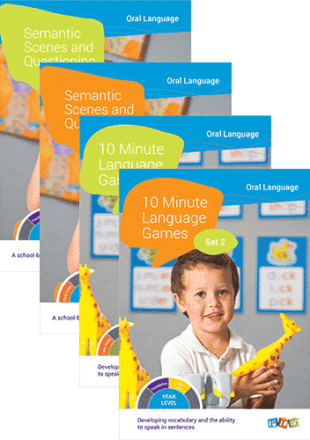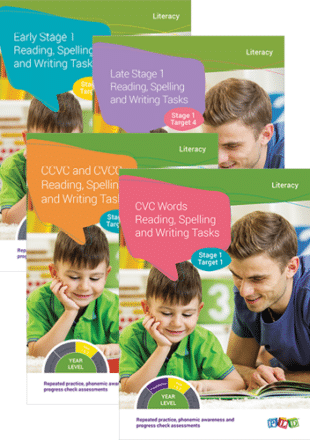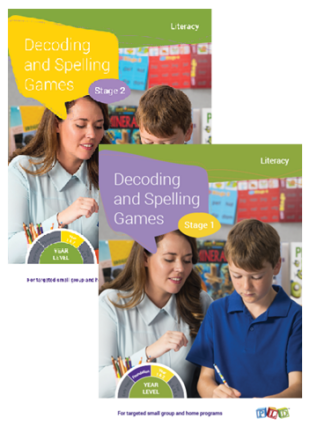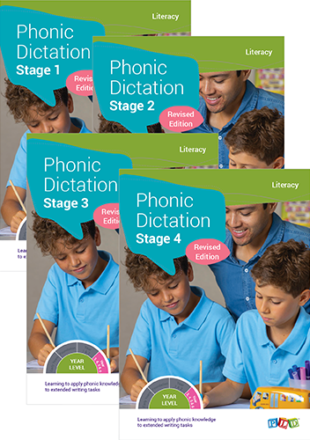Age
Showing 337–352 of 458 results
-
Sale!
Semantics Program for Early Years & Foundation – Full Set

The PLD Semantics program for Early Years & Foundation classrooms has been designed by speech pathologists for students between 3 and 6 years of age. Buy all four resources in a bundle and save 15%. Click on each of the links below if you wish to view the stages individually. Each program contains 5 and […]
The PLD Semantics program for Early Years & Foundation classrooms has been designed by speech pathologists for students between 3 and 6 years of age.
From $280.52 -
Sale!
Pre-spelling and early spelling

The set presents pre-spelling (‘sounding-out’ or phonemic segmentation) and simple early childhood initial spelling tasks (such as creating CVC spelling words with Wikki Stix).
The set presents pre-spelling (‘sounding-out’ or phonemic segmentation) and simple early childhood initial spelling tasks (such as creating CVC spelling words with Wikki Stix).
$197.51Original price was: $197.51.$167.85Current price is: $167.85. -
Sale!
Reading Games – Stage 1 set

These Stage 1 reading games can be played over and over and enable students to rehearse and strengthen their spelling and reading skills. This pack contains: Phonic Bingo Games – Stage 1 Decoding and Spelling Games – Stage 1 Teaching the First 100 sight words
These Stage 1 reading games can be played over and over and enable students to rehearse and strengthen their spelling and reading skills. This pack
-
Sale!
Middle & Upper Primary Spelling Essentials

Together the two resources form the basis of a middle and upper primary synthetic phonics spelling programs.
Buy both resources in a bundle and save 15%. Click on each of the links below if you wish to view the stages individually. Structured
From $140.26 -
Sale!
Junior Primary Spelling Essentials

Together the two resources form the basis of a junior primary synthetic phonics spelling programs. Buy both resources in a bundle and save 15%. Structured Synthetic Phonics Time Savers – Stage 1 & 2 Section 1: Ready to use spelling lists Section 2: Student spelling lists and activity templates Section 3: Rapid automatic reading Section […]
Together the two resources form the basis of a junior primary synthetic phonics spelling programs. Buy both resources in a bundle and save 15%. Structured
From $140.26 -
Sale!
Reading, Spelling and Writing Tasks: CVC to Target 4 Bundle

Repeated practice, phonemic awareness and progress check assessments
Designed by a Speech Pathologist for use in schools and the home, this program for 5 to 6 year olds focuses on reading, spelling and
From $280.52 -
Sale!
Decoding and Spelling Games Bundle – Stage 1 & Stage 2

A program to develop single word decoding and spelling skills for students operating at Stage 1 & 2. Games and tasks for targeted small groups and home programs.
Buy both resources in a bundle and save 15%. Click on each of the links below if you wish to view the stages individually. Over
From $140.26 -
Sale!
Phonic Dictation – Junior & Middle Primary Set
The increasingly complex dictation passages with embedded phonic concepts can be read, edited, copied and finally presented in the form of dictation tasks.
Phonic Dictation supports students to bridge the gap between correctly spelling test words and applying their skills to extended writing. By completing regular dictation tasks,
From $264.00 -
Sale!
Foundation Classroom Decodable Reading Books Multi-Set (6 x Sets 1 to 7)
PLD’s Decodable Reading Book Bundle comprises seven sets for Foundation – 170 books in total. Each set includes a carefully curated selection of titles that align with various phonics stages, ensuring a structured and effective reading experience. This Classroom Bundle comprises six copies of each full set (Sets 1 – 7), catering to larger groups or to provide as home readers for students. The Classroom Bundle consists of 1,020 books in total.
This Classroom Bundle comprises six Full Sets of PLD’s Decodable Reading Books for Foundation (Sets 1- 7). That is 1,020 books in total! PLD’s Decodable
From $1,721.25 -
Sale!
Foundation Decodable Reading Books Bundle (Set 1 to 7)
PLD’s Decodable Reading Book Bundle comprises seven sets for Foundation – 170 books in total. Each set includes a carefully curated selection of titles that align with various phonics stages, ensuring a structured and effective reading experience.
PLD’s Decodable Reading Books for Foundation are designed to support early readers by focusing on phonics and simple word patterns. The books introduce phonics and
From $1,190.00 -
Foundation Integrated SSP Kit and Foundation Reading Books Bundle (Set 1 to 7)
This bundle is expertly designed to provide a strong foundation for early literacy by combining SSP resources with engaging decodable texts. Together, they create a cohesive learning experience that helps young readers develop essential phonics skills while enjoying the reading process.
From $1,632.00$1,632.00 incl. GST[flipbook-popup id=''][/flipbook-popup] -
Junior Primary SSP Kit Bundle (Foundation to Year 2)
PLD’s Integrated SSP Kits streamline the teaching experience within the framework of PLD’s Structured Synthetic Phonics (SSP) program. The SSP Kit Manuals consolidate a full year of week-by-week teaching materials and Daily Reviews into one comprehensive kit.
From $1,780.75$1,780.75 incl. GST[flipbook-popup id=''][/flipbook-popup] -
Sale!
Middle and Upper Primary SSP Kit Bundle (Year 3 to Year 6)
PLD’s Integrated SSP Kits streamline the teaching experience within the framework of PLD’s Structured Synthetic Phonics (SSP) program. This bundle is designed to provide consecutive middle and upper classes with the teaching and learning materials needed to implement SSP in a consistent manner across classes and year levels. Together, these four kits create a cohesive learning experience that help young learners develop essential phonics skills while establishing strong foundations in reading, spelling and writing.
NOTE: The Year 3 & 4 Kits are available now. The Year 5 & 6 Kits are currently on preorder. PLD’s Integrated SSP Kits streamline
From $2,805.00 -
Sale!
Phonic Dictation – Full Set
The increasingly complex dictation passages with embedded phonic concepts can be read, edited, copied and finally presented in the form of dictation tasks.
Phonic Dictation supports students to bridge the gap between correctly spelling test words and applying their skills to extended writing. By completing regular dictation tasks,
From $420.78 -
Sale!
Year 1 Essential Classroom Decodable Reading Books Multi-Set (6 x sets 7 to 10)
PLD’s Decodable Reading Book Bundle comprises seven sets for Foundation – 170 books in total. Each set includes a carefully curated selection of titles that align with various phonics stages, ensuring a structured and effective reading experience. This Classroom Bundle comprises six copies of each full set (Sets 1 – 7), catering to larger groups or to provide as home readers for students. The Classroom Bundle consists of 1,020 books in total.
This Classroom Bundle comprises six Full Sets of PLD’s Decodable Reading Books for Year 1 (Sets 7 – 10). That is 540 books in total!
From $633.25 -
Sale!
Year 1 Essential Decodable Reading Books Bundle (Set 7 to 10)
PLD’s Decodable Reading Book Bundle comprises four sets for Year 1 – 90 books in total. Each set includes a carefully curated selection of titles that align with various phonics stages, ensuring a structured and effective reading experience.
PLD’s Decodable Reading Books for Year 1 are designed to support early readers by focusing on phonics and simple word patterns. The books introduce phonics
From $633.25










